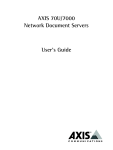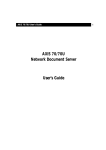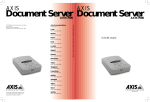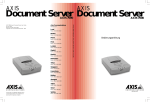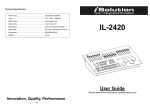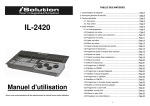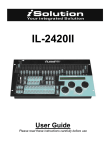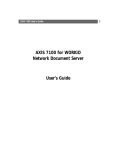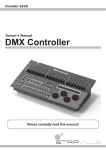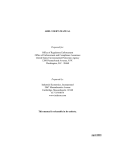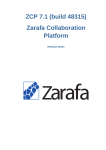Download Axis 7000 User`s guide
Transcript
AXIS AXIS Document Server Document Server AXIS 7000 Axis Communications www.axis.com Lund Phone: +46 46 270 18 00 Boston Phone: +1 978 614 20 00 Miami Phone: +1 305 629 3524 Paris Phone: +33 1 49 69 1550 London Phone: +44 207 553 9200 Madrid Phone: +34 91 803 46 43 Munich Phone: +49 89 95 93 96 0 AXIS 7000 Network Document Server User’s Guide AXIS 7000 Network Document Server User’s Guide Part No: 16541 Revision 2.0, Date : January 2000 Copyright © Axis Communications AB, 1997 – 2000 AXIS 7000 User’s Guide Rotterdam Phone: +31 10 444 34 34 Tokyo Phone: +81 3 3545 8282 Singapore Phone: +65 250 8077 Hong Kong Phone: +852 2836 0813 Beijing Phone: +86 10 6801 6023 Shanghai Convenient Document Distribution & Archiving over Networks Phone: +86 21 6372 5659 Taipei Phone: +886 2 2546 9668 Seoul Phone: +82 2 780 9636 The Axis logo is a registered trademark of Axis Communications AB. All other trademarks are owned by their respective companies. Sydney Phone: +61 2 9967 5700 www.axis.com AXIS 7000 User’s Guide 2 About This Document This guide applies to the AXIS 7000 Network Document Server with software release 2.10 and subsequent releases until otherwise notified. requirements for immunity according to EN55024 residential, commercial, and light industry (Compliance is not valid for unshielded network cables). Liability Take some time to read through the safety notices before installing the AXIS 7000. Please observe all safety markings and instructions when using this product. Every care has been taken in the preparation of this manual; if you detect any inaccuracies or omissions, please inform your local Axis office which can be found on the cover of this document. Axis Communications AB cannot be held responsible for any technical or typographical errors and reserves the right to make changes to the product and manuals without prior notice. Axis Communications AB makes no warranty of any kind with regard to the material contained within this document, including, but not limited to, the implied warranties of merchantability and fitness for a particular purpose. Axis Communications AB shall not be liable nor responsible for incidental or consequential damages in connection with the furnishing, performance or use of this material. Caution! - must be observed to avoid loss of data or damage Trademark Acknowledgments to your equipment. Acrobat, Adobe, AIX, DOS, Ethernet, IBM, Internet Explorer, Macintosh, Microsoft, Netscape Navigator, OS/2, UNIX and Windows are registered trademarks of the respective holders. The document provides introductory information as well as instructions on how to set up and manage the AXIS 7000. It is intended for anyone involved in installing and using the AXIS 7000. For more detailed instructions, refer to the AXIS 7000 User’s Manual that is available in online format at the Axis Website and on the AXIS Online CD. Safety Notices Important: - must be observed to avoid operational impairment. Do not proceed beyond any of the above notices, until you have fully understood the implications. Copyright Information The unauthorized copying of materials that are covered by copyright and other international proprietary or intellectual property rights is prohibited in most countries. Axis Communications AB recommends that the users of this equipment seek the necessary authorizations for copying material. The instructions for use in the manual shall not be considered as an inducement to make illicit duplications of material. Any duplication will be made at the user’s own risk. Electromagnetic Compatibility (EMC) USA - This equipment generates, uses, and can radiate radio frequency energy and if not installed and used in accordance with the instruction manual, may cause interference to radio communications. It has been tested and found to comply with the limits for a Class A computing device pursuant to Subpart B of Part 15 of FCC rules, which are designed to provide reasonable protection against such interference when operated in a commercial environment. Operation of this equipment in a residential area is likely to cause interference in which case the user at his/her own expense will be required to take whatever measures may be required to correct the interference. Shielded cables should be used with this unit to ensure compliance with the Class A limits. Europe - This digital equipment fulfils the requirements for radiated emission according to limit B of EN55022, and the AXIS COMMUNICATIONS <Product Name> Quick User’s Guide Software Trademark Acknowledgments JPEG code (libjpeg) used courtesy of the Independent JPEG Group. LDAP code (libldap and libber) used courtesy of the University of Michigan at Ann Arbor. Copyright © 1991 Regents of the University of Michigan. All rights reserved. TIFF code (libtiff) used courtesy of Sam Leffler and Silicon Graphics, Inc. Copyright © 1988-1996 Sam Leffler. Copyright © 1991-1996 Silicon Graphics, Inc. Maintenance It is recommended that you use a moist cloth to clean the unit. Do not use petroleum based substances as this may cause damage. Support Services Should you require any technical assistance, please contact your local dealer. If your questions cannot be answered immediately, your dealer will forward your queries through the appropriate channels to ensure you a rapid response. If you are connected to Internet, you can find online manuals, technical support information, software updates, application software, information about Axis etc. at the locations listed below. WWW: http://www.axis.com FTP server: ftp://ftp.axis.com/pub/axis AXIS 7000 User’s Guide Revision 2.0 Part No: 16541 Dated: January 2000 Copyright © Axis Communications AB, 1997 - 2000 AXIS 7000 User’s Guide Introduction . . . . . . . . . . . . . . . . . . . . . . . . . . . . . . . . . . . . . . . . . . . . . . . . . . . . 4 Product Overview . . . . . . . . . . . . . . . . . . . . . . . . . . . . . . . . . . . . . . . . . . . . . . . . 5 Physical Description . . . . . . . . . . . . . . . . . . . . . . . . . . . . . . . . . . . . . . . . . . . . . . 6 The Control Panel . . . . . . . . . . . . . . . . . . . . . . . . . . . . . . . . . . . . . . . . . . . . . . 6 Connectors and Indicators . . . . . . . . . . . . . . . . . . . . . . . . . . . . . . . . . . . . . . . . 7 Basic Installation . . . . . . . . . . . . . . . . . . . . . . . . . . . . . . . . . . . . . . . . . . . . . . . . . 8 Installation Summary . . . . . . . . . . . . . . . . . . . . . . . . . . . . . . . . . . . . . . . . . . . . 8 Checking the Hardware Inventory . . . . . . . . . . . . . . . . . . . . . . . . . . . . . . . . . . 8 Connecting Digital Copiers and Scanners. . . . . . . . . . . . . . . . . . . . . . . . . . . . . 9 Connecting the AXIS 7000 to the Network . . . . . . . . . . . . . . . . . . . . . . . . . . . 9 Assigning an Internet Address to the AXIS 7000 . . . . . . . . . . . . . . . . . . . . . . 10 Verifying the Installation . . . . . . . . . . . . . . . . . . . . . . . . . . . . . . . . . . . . . . . . 12 Configuring the AXIS 7000 . . . . . . . . . . . . . . . . . . . . . . . . . . . . . . . . . . . . . . . . 14 Accessing the Administration Tools . . . . . . . . . . . . . . . . . . . . . . . . . . . . . . . . 14 Specifying the Network Settings . . . . . . . . . . . . . . . . . . . . . . . . . . . . . . . . . . . 15 Specifying Destinations . . . . . . . . . . . . . . . . . . . . . . . . . . . . . . . . . . . . . . . . . 16 Specifying System Settings . . . . . . . . . . . . . . . . . . . . . . . . . . . . . . . . . . . . . . . 18 Using the AXIS 7000. . . . . . . . . . . . . . . . . . . . . . . . . . . . . . . . . . . . . . . . . . . . . 19 Sending to Destinations . . . . . . . . . . . . . . . . . . . . . . . . . . . . . . . . . . . . . . . . . 19 Adding E-mail Destinations . . . . . . . . . . . . . . . . . . . . . . . . . . . . . . . . . . . . . . 22 Adding Temporary Profiles. . . . . . . . . . . . . . . . . . . . . . . . . . . . . . . . . . . . . . . 23 Viewing the Scanned Images. . . . . . . . . . . . . . . . . . . . . . . . . . . . . . . . . . . . . . 24 Specifying a Sender. . . . . . . . . . . . . . . . . . . . . . . . . . . . . . . . . . . . . . . . . . . . . 25 3 4 Introduction AXIS 7000 User’s Guide Introduction This document provides introductory instructions on how to set up and manage the AXIS 7000 Network Document Server within your networking environment. Should you require more information, please refer to the AXIS 7000 User’s Manual, which is available from the Axis Website at http://www.axis.com or on the AXIS Online CD in PDF format. Important! Online help is available on every page within the AXIS 7000 Web interface. This is of particular relevance when configuring the unit and should be used as a first point of reference for any administration queries. The help system is stored internally in the AXIS 7000. AXIS Online CD The AXIS Online CD provides an easy-to-use electronic catalog, that includes all of the latest AXIS Utilities Software, Product Software, White Papers, User Documents, Technical References, Technical Notes, etc. It is compatible for use within all of the supported Axis computing environments. The AXIS 7000 is server independent and requires no additional software for installation purposes. Software on the online CD is merely optional for management and installation. You can view the contents of the AXIS Online CD via the Adobe Reader interface or HTML interface. All documents presented on the CD are in PDF format. Note: If the Adobe Acrobat Reader 3.0 or higher is not installed on your system: • Windows users should click Get Adobe Reader button from the main user interface. • Non-Windows users should locate and run the appropriate installer from the tools/Acrobat/ folder. Refer to the readme.txt file for full path name details. Axis official home page All of the software and information provided on the AXIS Online CD is also available from the Axis Website at http://www.axis.com. From this site you can access corporate and support information, learn more about other Axis products, etc. AXIS 7000 User’s Guide Product Overview Product Overview The AXIS 7000 Network Document Server utilizes your existing office equipment to distribute paper-based information across workgroups, organizations and the Internet. It is easily integrated into existing workflows and document management systems, it optimizes earlier office investments, reduces organizational overhead and significantly cuts mailing costs. Connecting digital copiers and flatbed scanners to 10 Mbps Ethernet and 100 Mbps Fast Ethernet networks, the AXIS 7000 allows documents to be easily distributed to any e-mail address, file server, fax server or printer. Supplied as a standalone unit that is typically located beside your scanning device, one AXIS 7000 is required for each digital copier or scanner. For convenient electronic distribution of copied materials to e-mail addresses and application servers, it is suggested that the AXIS 7000 and the scanning device be located in the mail or printer room - in close proximity to the workgroup or department users. 5 Physical Description 6 AXIS 7000 User’s Guide Physical Description The Control Panel The AXIS 7000 Control panel has several user keys and a message display that describes the selected menu options and current status of the unit. Note: • When sending your document, the product always uses the currently displayed destination and scanning options, whether explicitly selected or not . Key Description Add Scans the material in the scanning device. For bound material, use this key to scan each page. Cancel Cancels the scanning process at any stage and clears any selections made from the menu. Resets error messages. Menu Scrolls through the menu. Select Selects multiple destinations. Send Sends the scanned material to the selected destination and releases the AXIS 7000 for other users. For a single page/stack of paper, use this key to scan the material and send the image in one step. Up/Down Scrolls and selects menu options. AXIS 7000 version 2.10 Menu Ca d Ad nce l Select Send • It is also possible to connect a standard PC-AT Keyboard to the AXIS 7000. This allows you to enter e-mail addresses at the copier or search long e-mail listings easily and save any non-listed address as a temporary or permanent addition to the resident address list. See also Adding E-mail Destinations, on page 22. • For more detailed information, please refer to the AXIS 7000 User’s Manual at the Axis Website http://www.axis.com or on the AXIS Online CD. AXIS 7000 User’s Guide Physical Description Connectors and Indicators Push Button SCSI Connector Keyboard Connector Network Connector Power Supply Status Indicator Busy Indicator Network Power Indicator Indicator Network Connector - The AXIS 7000 is designed for 10 Mbps Ethernet and 100 Mbps Fast Ethernet networks and connects to the network via a twisted pair category 5 cable (10baseT and 100baseTX). The AXIS 7000 automatically switches between 10 Mbps and 100 Mbps. Keyboard Connector - A mini-DIN connector for connection of a standard PC-Keyboard. Refer to the AXIS 7000 User’s Manual for further details. SCSI Connector - A SCSI-2 connector for connection to the digital copier or scanner. Status Indicator - The Status indicator flashes during startup and remains lit when the AXIS 7000 is ready for use. If the Status indicator turns off, this may indicate an error. Busy Indicator - The Busy indicator turns on when the AXIS 7000 is allocated for use and remains on during the scanning process. Network Indicator - The tri-colored Network indicator flashes: yellow - indicating network activity on a 10MB Ethernet network. green - indicating network activity on a 100MB Fast Ethernet network. red - indicating that the unit is not correctly connected to the network. Power Indicator - The Power indicator is normally on when power is applied. If the indicator remains off or flashes, this indicates a problem with the AXIS 7000 or its power supply. Power Supply - The AXIS 7000 can use either the AXIS PS-C or AXIS PS-E power supply. Push Button - The Push button can be used for restoring the AXIS 7000 parameters to the factory default settings. See the AXIS 7000 User’s Manual at the Axis Website http://www.axis.com or on the AXIS Online CD for more information. 7 8 Basic Installation AXIS 7000 User’s Guide Basic Installation Installation Summary The AXIS 7000 is installed in the following stages: • Checking the Hardware Inventory • Connecting to digital copiers and scanners • Connecting the AXIS 7000 to the network • Assigning an Internet address to the AXIS 7000 • Verifying the installation Checking the Hardware Inventory Unpack and check all the items using the following list. Contact your dealer if anything is missing or damaged. All packing materials are recyclable. Hardware Models Part Numbers AXIS 7000 Network Document Server AXIS 7000 0094-1 Power Supply Europe 14235 UK 14236 Australia 14258 USA 14256 Japan 14257 Europe 15507 UK 15509 Australia 15510 USA 15508 Japan 15511 AXIS PS-C AXIS PS-E Media Title Part Numbers CD-ROM AXIS Online CD rev 5.4 or higher Printed Materials AXIS 7000 User’s Guide 16541 AXIS 7000 Instruction Label 16567 AXIS 7000 Keyboard Instruction Label 16763 Optional Accessories Description Part Numbers SCSI Connectors 50-pin high-density shielded SCSI connector (micro-D) 14260 50-pin high-density shielded SCSI connector 14259 (Centronics) AXIS 7000 User’s Guide Basic Installation Connecting Digital Copiers and Scanners Caution! • Check that the power supply included with your AXIS 7000 is marked with the correct mains voltage. • Make sure that the scanning device and the AXIS 7000 are switched off. The SCSI bus may become damaged if you connect or disconnect units when power is on. 1. Switch off the scanning device and disconnect the AXIS 7000 external power supply. 2. Connect the SCSI cable to the SCSI connector on the AXIS 7000. 3. Connect the SCSI cable to the scanning device. The AXIS 7000 uses a built-in SCSI terminator. Note that the scanning device must also be terminated properly. Refer to the documentation supplied with your scanning device. Connecting the AXIS 7000 to the Network 1. Connect your AXIS 7000 to the network. Note: The AXIS 7000 is designed for 10 Mbps Ethernet and 100 Mbps Fast Ethernet networks and connects to the network via a twisted pair category 5 cable (10baseT and 100baseTX) 2. Switch on the scanning device. 3. Connect the external power supply to the AXIS 7000. The network indicator will flash during power up and self test. The following message will appear on the display during self test: AXIS 7000 Version: x.xx where x.xx is the software version number, e.g. 2.10 Note: The tri-colored Network indicator flashes: • yellow - indicating network activity on a 10MB Ethernet network. • green - indicating network activity on a 100MB Fast Ethernet network. • red -indicating that the unit is not correctly connected to the network. 9 10 Basic Installation AXIS 7000 User’s Guide Assigning an Internet Address to the AXIS 7000 Follow the instructions below to set the IP address from the Control Panel. Important! • This section can be ignored if you are using DHCP, RARP or BOOTP, as the Internet address is set automatically (DHCP is the preferred method for Windows NT networks, as it automatically sets some of the parameters as well). • A valid and unused Internet address must be acquired from your Network Administrator. • Connecting a PC-AT keyboard directly to the mini-DIN terminator of your AXIS 7000 provides a convenient method for managing the unit, and setting the Internet address during system start up. The administrator can choose to disallow this function from the Administration pages. Please make sure that the AXIS 7000 power supply is disconnected before connecting the keyboard. • The IP address for your product can also be set using the AXIS IP Installer (included on the AXIS Online CD), or the ARP, RARP BOOTP or DHCP methods. Please refer to the AXIS 7000 User’s Manual for further details. 1. Power up the AXIS 7000 and press Menu when the message below appears: AXIS 7000 version: x.xx 2. After a few seconds this display will be shown: IP Address: 000.000.000.000 3. Press Select to edit the Internet address: Edit IP Address: 000.000.000.000 4. Press Menu 5. Use to move through and highlight each digit, one at a time. to increase or decrease each highlighted digit, as required. 6. Press Select to confirm the changes. 7. Press Menu to display the default router address setting: Default router: 000.000.000.000 AXIS 7000 User’s Guide Basic Installation 8. Press Select to edit the default router address: Edit router: 000.000.000.000 9. To change the value, repeat steps 4 - 6 above. 10. Press Menu to display the subnet mask setting: Net mask: 000.000.000.000 11. Press Select to edit the subnet mask: Edit net mask: 000.000.000.000 12. To change the value, repeat steps 4 - 6 above. 13. Press Menu to display the node address. This address is not editable. The node address should equal the AXIS 7000 serial number found on the underside label of the unit. 14. Press Menu once more to display the final instructions: Press if you are finished 15. Press Select to exit the Internet settings. The AXIS 7000 then completes the startup sequence. 16. Write the name or Internet address of the AXIS 7000 on the supplied Instructions label and attach it to the top cover. The unit is ready for use when the Status indicator stops flashing and remains lit. Note: If you make a mistake when editing the parameters, press Cancel operation. to cancel the previous 11 12 Basic Installation AXIS 7000 User’s Guide Verifying the Network Settings Access the Advanced menu from the AXIS 7000 control panel to verify that your chosen network settings are correct, as described below: 1. Press and hold down the Menu key while simultaneously pressing the Select key . The Advanced menu is displayed. 2. Use to find the Network Settings option. 3. Press Select 4. Use to enter the submenus. to scroll through and check the parameter settings. Verifying the Installation Upon successful installation, the AXIS 7000 will identify the attached scanning device and display its name. If the connected scanning device is not supported, an error message will be displayed. A list of supported digital copiers and scanners is available on the AXIS Website at http://www.axis.com If no destinations have previously been specified, the AXIS 7000 displays: Connect using Web browser If one or more destinations have already been specified, the AXIS 7000 will display: Send to: xxxxxx where xxxxxx is the first Destination Name. Note: • The Destination Name is the text that appears in the destination list on the message display. • Destinations are sorted in alphabetical order. To verify the installation, access the AXIS 7000 using a standard Web browser such as Netscape Navigator or Microsoft Internet Explorer, as described below: 1. Place a document in the scanning device. 2. Start your Web browser. 3. Enter the name or Internet address of your AXIS 7000 in the location/address field (URL). AXIS 7000 User’s Guide Basic Installation Example: http://172.16.253.80 The AXIS 7000 Home Page, the Scan Document page, is displayed. 4. Click Scan. Depending on the image format specified by the profile, the Web browser will display the image in an associated image viewer, or ask you to save the file. 13 14 Configuring the AXIS 7000 AXIS 7000 User’s Guide Configuring the AXIS 7000 This section is targeted specifically to users responsible for the administration of the AXIS 7000. Administrator(s) are granted with high-level privileges that are denied to the ordinary user(s). The following settings must be specified by the administrator before the AXIS 7000 can be used for distributing reproduced documents on your network: • Network settings: define the parameters for TCP/IP and SMTP protocols. • Destinations: specify the e-mail address, file server, or printer to which you wish to send your document. Note: • If you have an active DHCP or BOOTP server on your network most network settings will be set automatically. However, it is strongly recommended that you verify the settings from the Web browser interface. • When installing the AXIS 7000 for the first time, it is recommended that the Administrator retains default system settings, profiles and paper sizes. The settings can be optionally customized at a later date once you are familiar with the unit operation and functionality. • Refer to the User’s Manual for information on the settings for profiles and paper sizes. • It is possible to enable user authentication to restrict use of the AXIS 7000 to validated users only. For more information, please refer to the AXIS 7000 User’s Manual at the Axis Website http://www.axis.com or on the AXIS Online CD. Accessing the Administration Tools The Web-based Administration tools provide a convenient method for managing destinations, profiles, defining the network protocol settings, establishing user privileges, authentication etc. The AXIS 7000 Administration pages are password protected and available to the Administrator(s) only. Follow the instructions below to access the Administration tools using a standard Web browser, such as Netscape Navigator or Microsoft Internet Explorer. 1. Start your Web browser. 2. Enter the name or Internet address of your AXIS 7000 in the location/address field. Example: http://172.16.253.80 The AXIS 7000 home page, Scan Document is displayed. AXIS 7000 User’s Guide Configuring the AXIS 7000 3. Click the Admin button to display the This AXIS 7000 Web page. Enter the username and password, default to user and pass respectively. You are now registered as an Administrator and ready to specify the Network settings and Destinations. Specifying the Network Settings Referring to the information services table below, use the Wizard to configure the TCP/IP and SMTP settings. Optionally, configure the External Address Book for automatic retrieval and loading of e-mail addresses and/or Web(HTTP) definitions: 1. Click Network Settings. 2. Click Wizard for the AXIS 7000 to guide you through the configuration procedures for each of the supported network protocols. This is a convenient way to set up your AXIS 7000 in your network environment. 3. Click Detailed View to verify the settings. The table below provides a one-stop overview of the supported protocol settings describing both purpose and function: Protocol setting Purpose and function TCP/IP Defines the IP address, default router and subnet mask, automatic download method (BOOTP, RARP or DHCP), domain name and DNS server. E-mail SMTP Defines the IP addresses or DNS names for primary and secondary e-mail servers, connection timeout and e-mail reply address. Web (HTTP) An external URL reference with URL to page or image options. External Address Book Defines a list of e-mail addresses resident on an LDAP server, or a list of e-mail, printer and/or file destinations on an FTP server. These can be automatically retrieved and added to the AXIS 7000 destination list. 15 16 Configuring the AXIS 7000 AXIS 7000 User’s Guide Specifying Destinations A destination is defined as an e-mail address, file server or printer and can be created either automatically or manually. Specifying a destination automatically Specify a destination automatically by referencing a list of e-mail addresses on an LDAP server, or a list of e-mail, printer and/or file destinations on an FTP server. Refer to Specifying the Network Settings (above) for details. E-mail destinations can also be designated as either permanent or temporary. Note: • All E-mail addresses are displayed on the AXIS 7000 message display, regardless of whether they are loaded automatically or manually. However, only manually-loaded e-mail destinations are shown in the AXIS 7000 Destinations page. • For more information, please refer to the AXIS 7000 User’s Manual at the Axis Website http://www.axis.com or on the AXIS Online CD. Specifying a destination manually 1. Click Destinations. The table lists the currently available destinations. If you allow users to add temporary e-mail destinations, these will appear at the top of this table. 2. Click Make Permanent only if you want to make a temporary e-mail destination permanent. The Make Permanent button will only appear if there are temporary destinations available. Note: • Click Destination Defaults to specify the destination default settings, e.g. the default profile. • Click E-mail Subjects to specify default e-mail subjects. AXIS 7000 User’s Guide Configuring the AXIS 7000 Adding New Destinations From the Admin - Destinations Web page, follow the appropriate instructions below to add new e-mail, printer or file destinations: Destination Type Options / Description Instruction E-mail • Click E-mail Destination New>> With the image included as an E-mail attachment • Specify the new E-mail address, Destination name, Profile and the required Image information. • Click Scanned image as attachment. • To save the new destination, click Add To List • After adding all required destinations, click Done. Containing a URL hyperlink that references a storage location on an FTP server • Click E-mail Destination New>> • Specify the new E-mail address, Destination name, Profile and the required Image information. • Click URL that points to scanned image • Click Add To List • After adding all required destinations click Done. Note: If you have not previously specified the storage location for the scanned image, do this now using the URL for E-mail>>. Printer File Raw TCP/IP Printing LPD Printing • For information, please refer to the AXIS 7000 User’s Manual at the Axis Website http://www.axis.com or the AXIS Online CD. File on an FTP server • Click File Destination New>> • Specify the Destination Name, Profile and the required Image information. • Enter the name or Internet address of the FTP Server and appropriate User and Password information. • Specify the target Directory and File Name. Optionally, define any file extension or sequence number preferences. • Click Add to List. • After adding all required FTP Servers, click Done. Note: • All destination types appear in the same list and all destinations are sorted in alphabetical order. • To specify the default settings, e.g. the default profile, click Destination Defaults. 17 18 Configuring the AXIS 7000 AXIS 7000 User’s Guide Specifying System Settings Follow the instructions below to set “system information”, “administrator password”, “password protected user privileges”, “language” etc. 1. Click This AXIS 7000. The system settings are displayed. 2. Click Edit to change any of the system parameters. It is recommended that you set a Server Password for protecting the Administration pages. The table below provides a one-stop overview of the information and services provided by each button on this page: Button Description Edit Allows display and modification of the General, Date & Time, User Options, International described below: General: enter Server Password and confirm, Date & Time: enable date and time information from a time synchronization source or set manually. User Options: allow/disallow privileges allowed to normal users, namely: • Add temporary e-mail destinations • Add temporary profiles • View documents in Web browser • Specify the sender of scanned documents • Configure network settings on the control panel International: select the supported language displayed on the AXIS 7000 message display (English, French, German, Italian, Spanish or Swedish), select keyboard layout compatible with the external keyboard and the measurement units used for displaying defined paper sizes (centimeters or inches). View Settings Lists the current parameter settings in the configuration file. Restart Server Restarts the AXIS 7000. Removes all previously loaded temporary destinations and profiles are removed from memory. Factory Default Restores the factory default settings and restarts the AXIS 7000 automatically. All previously loaded destinations and profiles are erased from memory. Supported Devices Displays a list of the supported digital copiers and scanners Note: If you lose the Server password, you will need to restore the factory default settings. Refer to the User’s Manual on how to do that. Note that all your current settings will be lost. AXIS 7000 User’s Guide Using the AXIS 7000 Using the AXIS 7000 The services provided to normal users are determined by the administrator when configuring the product. This section describes all services that can be made available to a user, namely: • Sending to destinations • Adding temporary e-mail destinations • Adding temporary profiles • Viewing the images • Specifying a sender Note: Administration instructions for setting user privileges are provided in Specifying System Settings, on page 18. Sending to Destinations Follow the instructions below to send information to one or several e-mail, printer or file server destinations - directly from the AXIS 7000 control panel: 1. Check that the following message is displayed; this indicates that the AXIS 7000 is ready for use: Send to: xxxxxx Where xxxxxx is your chosen destination, e.g. e-mail address, file, or printer. Note: If the following message is displayed your administrator has enabled authentication and you must enter your user name and password. For further information, please refer to your network administrator or to the User’s Manual at the Axis Website http://www.axis.com or the AXIS Online CD. User Name: 2. Use the scrolling keys to find your required destination from the list. Press and hold the key to autorepeat scrolling. If you want to add a temporary e-mail destination, refer to Adding E-mail Destinations, on page 22. 19 20 Using the AXIS 7000 AXIS 7000 User’s Guide 3. If you want to send the image to more than one destination, press Select choose each destination: to Send to:.......+13 Accounting Dept Note: • When sending to a printer, note that the image can only be sent to one printer at a time. • The image can not be sent to another destination type if a printer destination was previously selected. 4. Repeat steps 2 and 3, until all desired destinations are selected. Note: The image will always be sent to the destination currently shown, whether explicitly selected or not. So, be careful not to transmit images to an unwanted destination!. 5. Optionally, press Menu to change the default scanning parameters. You can select temporary settings for profile, paper size and double-sided. Use to select the desired value. Note: Press Cancel be cleared. to reset all temporary settings to the default values. All selected destinations will 6. Insert a single page on the flatbed or a stack of paper into the sheet feeder of the attached scanning device. For one single page or a stack of paper in the sheet feeder: a. Press Send one step. to scan and send the image to the selected destination in For several separate pages or stacks of paper: a. Press Add to scan each page. b. Insert the next page and press Add all your pages are scanned. c. Press Send again. Repeat the procedure until to transmit the image to the selected destination. AXIS 7000 User’s Guide Using the AXIS 7000 7. During the scanning this message is displayed: Scanning #1 please wait When you have pressed Send and the transfer of the scanned image is completed, the AXIS 7000 is released for other users. Note: The AXIS 7000 keeps all temporary settings in memory for one minute after the last scanning job or until user is logged out, and then returns to its default settings. Multipage Image Files - Multipage documents are by default collated and output into a single image file if PDF or TIFF is chosen. From a Web browser, deselect the All pages in one file parameter only if you want each page to appear separately in several PDF or TIFF files. Note: • The JPEG format always sends each page as one separate image file. • TIFF viewers not supporting multipage image files require that the Multipage Documents parameter is set to Separate file for each page using a profile. Alternatively, scan each page using Send • . Multipage documents cannot be collated into several separate PCL files, but are always merged into one file. Paper Orientation on Digital Copiers - To receive an upright image, the setting should be “Portrait” and the paper should be placed with the short-edge in the feeding direction in the ADF (Automatic Document Feeder) or in the A4-R position on the flatbed inside the digital copier. The PDF rotation option can be used to enable the same feeder orientation as when copying i.e long-edge first. This is true for all supported digital copiers except the Sharp AR-series which always supports the same orientation as when copying i.e. long-edge first. 21 22 Using the AXIS 7000 AXIS 7000 User’s Guide Adding E-mail Destinations The e-mail list resident within the AXIS 7000 is initially created by your administrator. If you want to send a document to an e-mail destination that is not featured in the list, you can add a temporary e-mail destination using either: • a standard PC keyboard, or • any standard Web browser Using a standard PC Keyboard Connecting a standard keyboard to your AXIS 7000 will allow you to quickly search for any destination names within the resident list. You can do this by simply typing in the first couple of characters of the destination name you wish to search. The AXIS 7000 message display will automatically show the destination that best matches the keyboard input. Adding a new e-mail address to the list: 1. If the keyboard is not already connected, make sure that the power supply to the AXIS 7000 is disconnected and connect the keyboard to the keyboard connector located on the rear panel. Reconnect the power supply. 2. Press the Insert key on your keyboard. The following prompt will appear on the message display: Add address: 3. Type the new e-mail address you want to add, and press Enter. Note: Only the five most-recently added temporary destinations will appear in the destination list. Contact your Network Administrator if you want to add a destination permanently. AXIS 7000 User’s Guide Using the AXIS 7000 From a Web browser: Follow the instructions below to remotely add temporary e-mail addresses to the address list: 1. Start the Web browser. 2. Enter the name or Internet address of your AXIS 7000 on the location/address line. This brings you to the AXIS 7000 Home Page. Example: http://172.16.253.80 3. Click Destinations. The table lists the available destinations. 4. Click New Destination and specify the settings for the new destination. 5. Click OK to save the destination temporarily. Note: Only the five most-recently added temporary destinations will appear in the destination list. Contact your Administrator if you want to add a destination permanently. Adding Temporary Profiles If you have tried all the available profiles but are still not satisfied with the result of your image, you can add a temporary profile from the Web browser interface. 1. Start the Web browser. 2. Enter the name or Internet address of your AXIS 7000 on the location/address line. Example: http://172.16.253.80 3. This brings you to the AXIS 7000 Home Page. Click Profiles. 4. The table lists the available profiles. Click New Profile and specify your settings. If you place a document in the scanning device, you can click Scan to monitor the results. 5. Click Add to save the profile temporarily. Contact your Network Administrator to make a profile permanent. 23 24 Using the AXIS 7000 AXIS 7000 User’s Guide Viewing the Scanned Images The AXIS 7000 creates images in standard TIFF, JPEG, PCL and PDF formats. Note that these files are merely images that do not include searchable text. Please contact your system administrator if you are unsure about which format to use. Note: • Use a standard Optical Character Recognition (OCR) application to convert documents to an editable and searchable format. Most OCR tools support TIFF. • Use Adobe Acrobat to capture text in PDF documents and convert it to bitmap text that can be corrected, indexed, searched, or copied to other files. • PCL file format is primarily used for Send-to-print functionality. For further processing, you will need appropriate image applications that support the generated file formats. A list of such tools is maintained on the AXIS 7000 Website at http://www.axis.com/products/axis_7000/ Associating Image Formats with Applications Applications are typically associated with a file format automatically during the installation procedure. If not, it is recommended that you manually associate your image applications with the supported image file formats, so that double-clicking on an image icon launches the appropriate application. In Windows 95/98 and NT, follow these steps to associate an application with a specific file type: 1. In Windows Explorer, open the View menu and select Options. 2. Click the File Types tab. 3. To create a new file type, click New Type. To modify the settings for an existing file type, click the type, and then click Edit. 4. Specify a description for the file type and the file name extension associated with this type of file. 5. Click New to define an action for this file type. 6. In the Action field, type Open. In the Application used to perform action field, specify the path to the application you want to use for opening files that have this extension. AXIS 7000 User’s Guide Using the AXIS 7000 Specifying a Sender If the Administrator has enabled users to specify the sender of scanned documents you can also identify yourself, your department or organization as the sender of distributed information directly from the AXIS 7000 Control Panel, as follows: 1. Press Menu display. 2. Use repeatedly until the Sent by: prompt is shown on the message to select any destination name as the registered sender. Note:. This does not apply when user authentication is enabled as the sender is automatically set to the logged in user and can not be changed. Administrators are referred to Specifying System Settings, on page 18 for information on how to configure normal user privileges. 25

























